Greenwich planners recommend approval of 1,500 homes at Morden Wharf
Greenwich Council planners are recommending approval of 1,500 homes at Morden Wharf from developer U&I when it goes before the council’s Planning Board in September.
This site covered the plans extensively when submitted back in July 2020. Click here to take a look.

In what a cynic might see as a sweetener for approval, the Gloriana Boathouse (the Queen’s row barge moored at St Katherine’s Docks) is proposed to be located on the river:
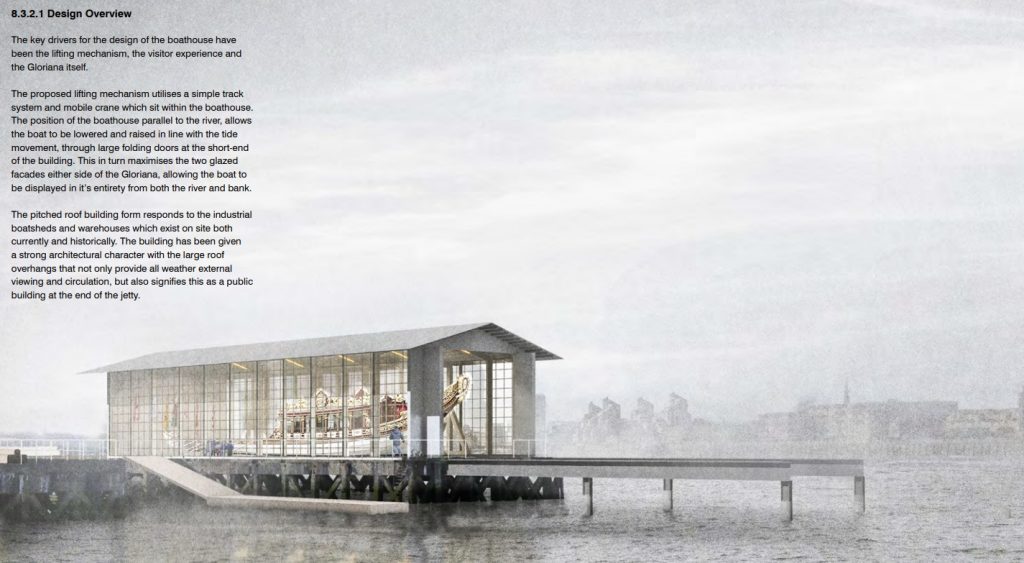
A contentious element is “flipping” the safeguarded wharf, with housing planned on what was a protected wharf, which is now moved to the north permitting this development.
The Secretary of State for Housing, Communities & Local Government approved the change in February 2021.
Developer U&I have so far owned the land for 12 years without building.
Transport
The site has a very poor level of public transport accessibility.
Bus route 108 is expected to divert into the site if plans approved – though that is far from enough for 1,500 homes.
The reports states “a bus service within the site and a financial contribution towards its implementation of £2.5m”.
A new river boat service is planned, and Thames Clippers would see up to £225,000 per year.

Parking space provision is for “45 [spaces] would be provided at the outset, and up to 150 spaces provided at completion, to be provided within the basement level.
Additionally, 45 spaces would be provided/retained for operational reasons for the industrial uses within the SIL, and 5 car club spaces would be provided.”

It also states “public realm contributions for off-site works to improve pedestrian and cycle links”, but this is Greenwich, with a truly woeful record in improving pedestrian and cycling links in parts of the peninsula.
Improving this will be absolutely key to making the development work.
They note that “the nearest station (North Greenwich) approximately one-mile walking distance away”.
It’s not pleasant:
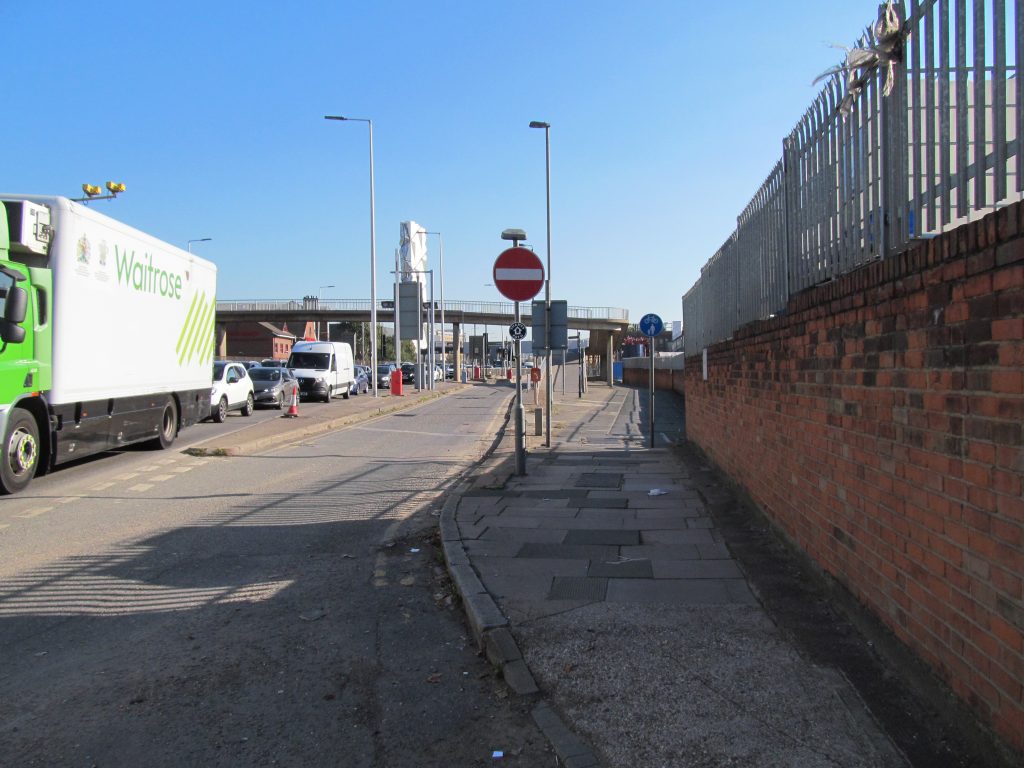
So there’s recognition work is badly needed, yet a figure of £250,000 is given for public realm upgrades, which may prove to be far from enough.
GLLaB sees over £1.5 million, and then £10 per square metre for business and town centre developments. Whether they will include this in that total remains to be seen.
They also state there will be “on-site improvements to permeability” which is a given as a developer is hardly not going to improve public space in the development.
That’s not what needs to be worried about, but rather off-site linking to amenities.
It’s hard to have anything but minimal faith in the authority making any effort to improve links to North Greenwich tube and attractions like the o2, which will naturally be of major appeal to residents.
£250,000 for cycling and pedestrian improvements is pretty low given the sum for river boat services at £225,000 per year. That also needs to cover the Thames Path.

What is likely is that the authority expect Silvertown Tunnel work on a new footbridge (which itself doesn’t exactly look enticing) to be sufficient, and then do little either side.
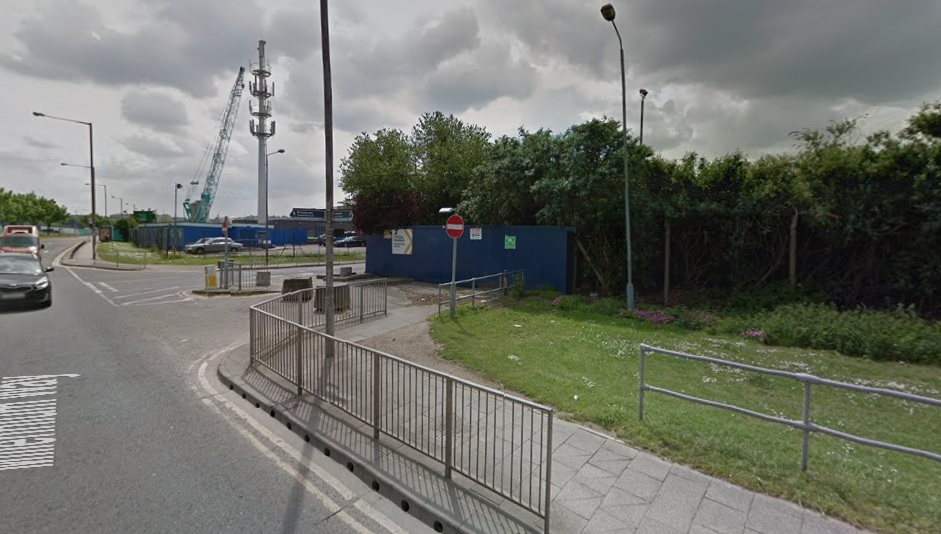
A glimpse of this is seen in the segment “Sea Witch Lane would be improved with a new and improved tree lined street linking Tunnel Avenue with the riverfront, to include integrated benches and cycle parking, and has been designed to provide a pedestrian/cycle friendly environment adjacent to Morden Park Square.”.
Great, but they need to radically upgrade the stretch from Tunnel Avenue site entrance to the footbridge over the Blackwall and Silverton Tunnel entrances and then along Boord Street towards North Greenwich.
They do reference Travelodge’s plan for a hotel en route that was recently approved, yet work planned there was pretty modest. Again, GLLaB swallowed most money with £147,411 compared to just £50,000 on measures to encourage sustainable travel.
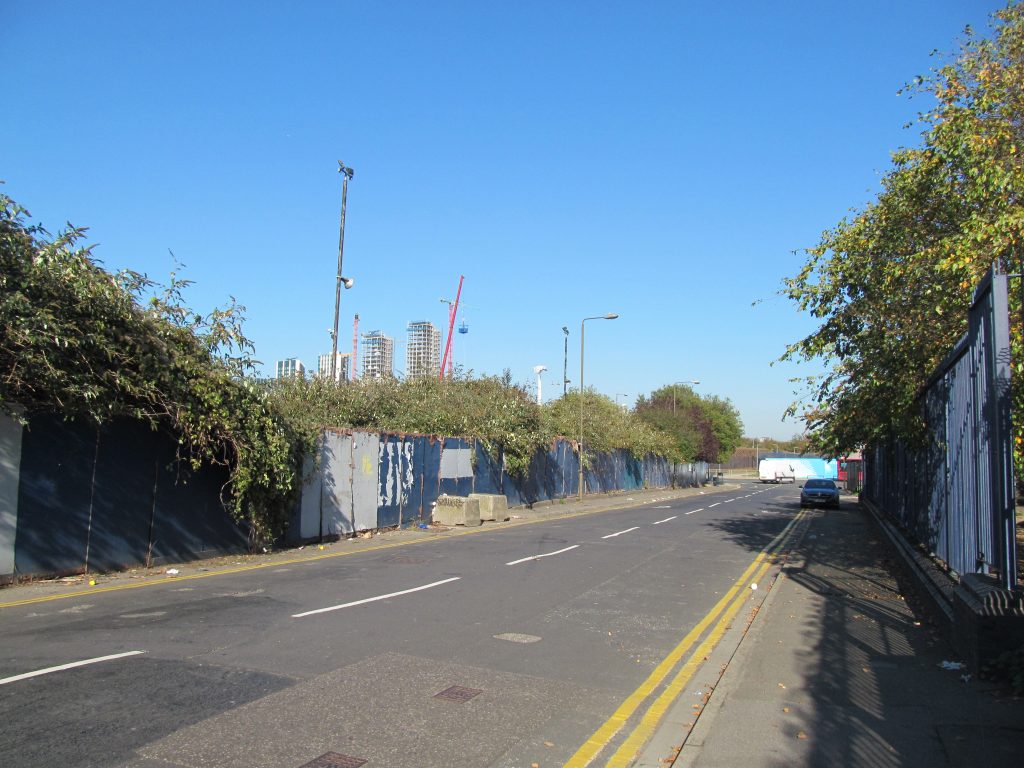
Boord Street doesn’t even have paving on one side of the road.
And neither do some roads to the north of here.
Health and education
A new health centre is proposed, with “up to 1,400m2 of healthcare provision on-site, to be offered for use by the CCG as a centralised Healthcare Hub for the wider area”
The plan also includes provision of a nursery and a £4.8m contribution toward a new primary school.
Affordable
“Affordable” housing is set at 31 per cent, with a 70/30 split between “affordable rent” and 30 per cent intermediate “affordable”.
The planners report states “this would be proportionally higher than a number of nearby consented schemes (including the Knight Dragon Masterplan and Greenwich Millennium Village)”.
The site is deemed suitable for tall buildings given the “allocated status of the site in the draft Site Allocations document and the site’s location within an Opportunity Area and a Strategic Development Location, it is considered that the scale and density of the proposal, subject to the mitigation outlined in this report, can be supported in line with London Plan polices which encourage greater densities in strategically designated areas, and in support of this, it is recognised that the site is considered suitable for tall buildings.”
Since then Woolwich & Greenwich MP Matt Pennycook has written to oppose the plans.
His opposition divided opinion as he objected to but towers in an area that is mostly industrial land.
One line in particular gained attention, which was that “it would have a detrimental impact on the existing character of the area and local heritage assets”.
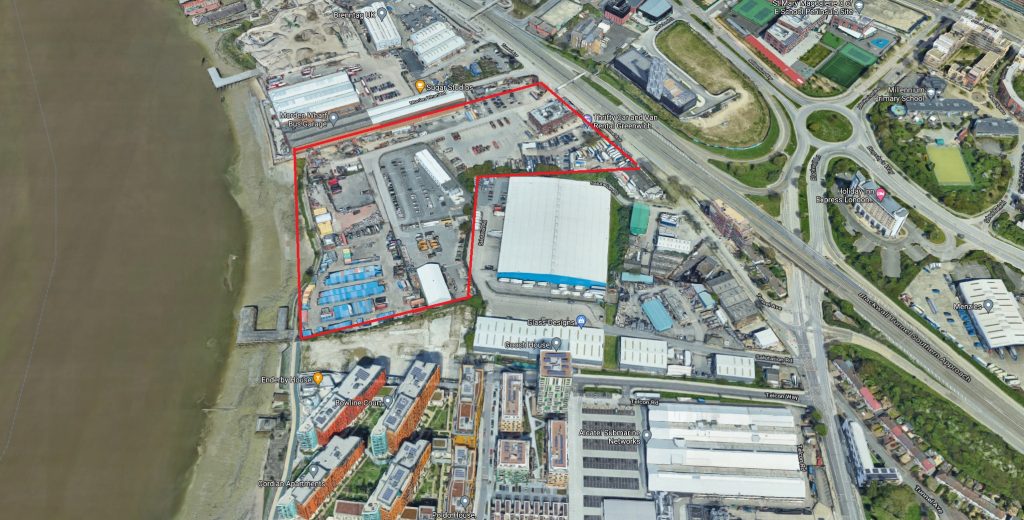
The surrounding context is mostly industrial land, dual carriageways and new-build blocks.
He objected to height, though outline approval has already been given to towers directly next door, with outline plans also approving towers to the north and other areas of the Peninsula.
If these plans were reduced in height to those next door, a wall effect would be visible from the river rather than gradually rising heights to a centrepiece as planned.

In the letter he stated there would be an “abrupt” rise in height if Morden Wharf is built, though the outline approval for towers at Enderby Place would fill the gap in approved outline plans or revised future plans.
In terms of design, the taller blocks appear to have more effort placed into them than the somewhat plain and dull smaller blocks.
Greenwich’s Conservation Officer states that blocks may detract from Blackwall Tunnel’s entrance portal with towers “looming over”.
Given the complete state of this area, I’m not sure it could be much worse. They do note “highways paraphernalia” already exists.
Views
They also mention the impact on views from Greenwich Park, but hasn’t that ship long sailed? For me, what makes the view so good – and the best in London – is that 1,000 years of London’s history is laid out in front covering every stage of London’s history up to the present.
They then state: “Generally: the close grouping of the buildings prevents them being viewed as isolated point blocks.
As such, they are, in almost every view, seen as a tall barrier block”.
Tall buildings almost almost work best as cluster gradually rising in height instead of low rise structures then a tower plonked in the middle.
Reducing heights to the same level as neighbouring plots would create a barrier appearance, and so instead the current design with a collection of towers with it’s future neighbour creates a tapering effect instead of a wall consisting of various buildings of similar height.
There’s a also a failure to acknowledge that London’s population has risen by over 1 million over the past decade and Greenwich borough’s annual housing targets are being routinely missed.
Future plans
It appears the landowner behind this plan also owns land to the north and east:
The council report is somewhat outdated as it states there is a neighbouring “distribution facility (operated by Spicers)”, however Spicers went bankrupt over a year ago.
Whether that land will see forthcoming housing plans remains to be seen.
It should also be noted that all the figures mentioned above such as £2.5 million for buses and £250,000 for public realm is only Section 106/278 income.
The Community Infrastructure Levy (CIL) total for this site could hit an additional £5 million, and then there’s New Homes Bonus income if the scheme is still in operation.
As for CIL and Greenwich’s apparent failure to collect it from developers (they are currently last among of all London boroughs), I’m working on a post about that coming soon.
Running a site alone takes time and a fair bit of money. Adverts are far from enough to cover it and my living costs as a private renter.
You can support me including via Paypal here Another option is via Patreon by clicking here You can also buy me a beer/coffee at Ko-fi here There's also a Facebook page for the site here Many thanks





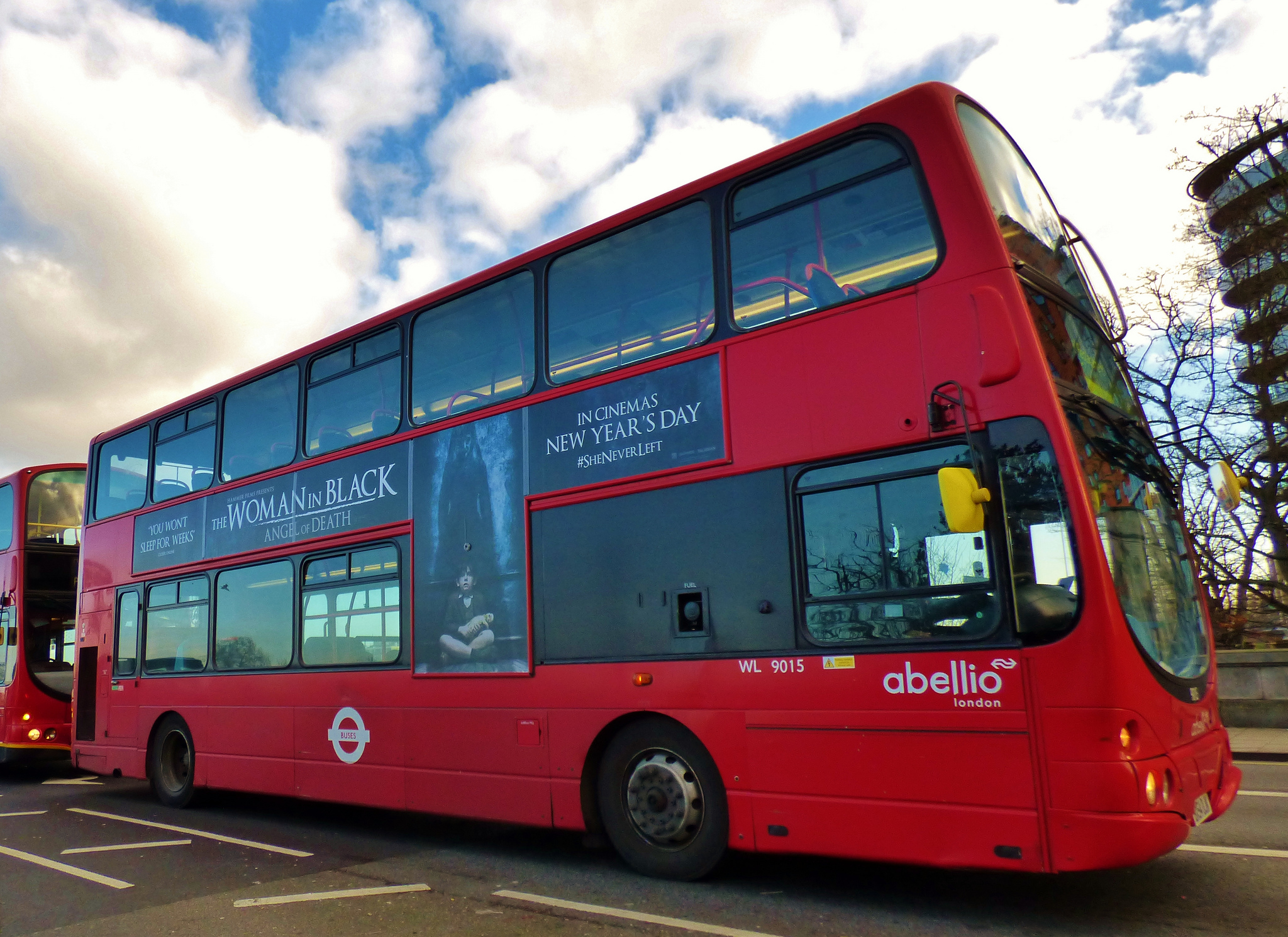
In a nutshell, too many high rises locally already, doesn’t solve housing problem, never will, just inconveniences locals, and makes money for developers, investors and second home owners. This is prime riverside, make it green, low rise, and a leisure area for Londoners to escape fossil fuel traffic and pollutants by walking and cycling.
Yeah nobody is hurt by deterioration of view or loss a historical sights when buuilding a tower there. the higher the better.
In terms of access to transport, they will just all have to go the tube via the thames path which isnt too bad of a walk.
The elephant in the room is as you poont out rightly the industrial wasteland on the other side. Any building here surely improves the current state of affairs, but then, is it desirable, ethical even to build right next to the tunnel entrance, which must be one of Londons most polluted spots? Something tells me on what side the afforable houses are going to be, this might be causing some long term damage.
It won’t look anything like the images. It’s a sad decision and a slippery slope for all the next developments in Greenwich.
What about its energy and carbon performance (inc materials)?
There will be Overheating due to single aspect highly glazed facades, esp on the corners. Lots of the new flats in the area already have ‘plug in’ air con with a vent hanging out the open windows. So all good for climate change then.
More off plan investments for renting rather than homes I would have thought, so may not be an issue for the landlords.
We really do need a massive rethink about our spaces and homes. We continue to get it wrong, build high, build dense, fail to make communities and the people get left with it long term.
I thought the new London plan wanted 50% afforable with a minimim of 35%?
This one is more about maximising profit as far as possible then disappearing. Much like convoys wharf will be. Its a missed opportunity to do something special on a site that needs development, then again the developers don’t care… On to the next one, our community gets left to deal with it.
Low rise when London’s population is projected to reach 10 million in the next decade from above 9 million currently?
That just means more sprawl onto greenery out of London.
The riverside from Cutty Sark to the O2 really should be like West Wapping to Canary Wharf – it’s very good up until Enderby House and then it gives up. It would do wonders for the accessibility of the station for walkers and cyclists if this were built all the way up, would avoid the horrendous walking infrastructure under the A102 (which, let’s be honest, will never be a pleasant place to be walking or cycling) and would also encourage other developments. As a cyclist I’d also far prefer cycling this route than the poorly designed segregated cycle lane they have introduced on Trafalgar Avenue.
Frustrating.
Trafalgar Rd*
@Jo: there are plenty of brownfield sites, admittedly more expensive to develope, so talk of greenery sprawl is rather emotive. Going high is not necessarily the best and certainly not for the elderly, disabled or those with young children who might find themselves with the choice of a upper floor property or nothing. There must be diversity in residential accommodation.
Some of your correspondents seem to have missed the interesting news that London has lost at least 3/4 million people in the last year so maybe that 10 million figure has disappeared into the Covid long grass. Lots of families from around East Greenwich have moved out to greener, cleaner parts now that home working looks to be the continuing future for lots of those desirable financial services jobs that keep London ticking over. So perhaps a rethink on the kind of homes we are offering people – as well as what is sustainable in a zero carbon world – would be a good thing. After all, London shed population from the 1940s until the late 1980s and that could well happen again.
Is there evidence for that?
I read predictions of it happening, yet for example votes cast at the last mayoral elections were no lower than 4 years previously accounting for turnout etc.
750,000 people leaving should have impacted voter numbers but didn’t.
Council reports on housing demand also showed little sign of reduction over the past year. It’ll be interesting to see the numbers in future reports.
The decline from the 1940s was active government policy which isn’t the case this time. Of course things can happen without government direction to an extent, but with no mass new towns being built as there was post 1940s, there’s a limit to where people can move to.
Another key thing to watch will be overseas student demand for London in coming years.